IDEX Online Research: Global Polished Diamond Prices Stable in August
September 03, 09
Despite higher rough diamond prices and repeated attempts by rough diamond traders to push up diamond prices further down the pipeline, global polished diamond prices in August showed virtually no change from the previous four months, according to the IDEX Online Polished Diamond Price Index.
This trend confirms inflation data at other levels of the jewelry industry: diamond price inflation came to a halt this summer at both the retail level and at the supplier level. It is clear that inflation has also disappeared at the producer cutting and polishing level in the industry.
Polished diamond prices during August showed more movement than in prior months. Daily fluctuations were notable, and prices for large stones – four and five carat gemstones – showed some distinct changes during the month. We believe this was due to the thin trading market in August, when many diamond traders were on holiday. However, when these daily price fluctuations were smoothed and average, diamond prices were essentially flat during the month.
The IDEX Online Polished Diamond Price Index averaged 108.67 for August, down marginally from 108.84 in July. At the end of August, the IDEX Online Index was 108.82, roughly in line with 108.76 at the end of July. In short, there has been no meaningful movement in polished diamond prices over the past month.
Many factors appear to be affecting polished diamond prices in the current recessionary environment, including the following:
- Rough diamond prices have risen, putting much pressure on polished diamond suppliers to raise prices. Unfortunately, demand further down the distribution channel has not materialized, so polished prices have not moved higher. That has left rough diamond traders with a significant inventory of uncut gemstones, and it has put pressure on their cash balances and debt levels.
- There was some optimism after the IIJS show. As a result, suppliers tried to implement higher prices for polished diamonds. However, when these price increases did not hold, polished diamond prices slipped back to the point equilibrium, with the IDEX Online Index holding steady at around 108 to 109.
- From time to time, there have been momentary bursts of demand for polished diamonds. For example, there was some optimism for five-carat diamonds in June and July, but prices slipped significantly lower in August when demand for those large stones evaporated. Conversely, there was a spike in demand for four-carat diamonds in August, which drove prices higher. It is unlikely that demand for four-carat diamonds will remain strong enough to sustain the current prices.
- Demand worldwide for diamonds and diamond jewelry at retail remains soft as consumers have cut back on luxury purchases. However, there have been some signs of improving demand in selected markets.
- Jewelry retailers have cut back dramatically on re-orders for diamonds and diamond jewelry in an effort to conserve cash as well as more closely align inventory levels to sales trends.
- The decline in polished price demand is magnified at each step back into the pipeline, beginning at the retail level. While U.S. specialty jewelers’ sales are down only about 15percent so far in 2009, some diamond miners report that demand dipped by as much as 90percent earlier this year. The polished diamond market is only two steps removed from the mining market (with the rough diamond market in between these two markets). Thus, sales are weak, and demand does not support higher prices.
- Early in the cycle, some polished diamond suppliers dumped diamonds at depressed prices in an effort to raise cash. This has offset price increases that some dealers have attempted to implement.
- Finally, summer vacations began in July and continued through August. This virtually insured that prices would not move sharply up or down.
The good news is this: for the first time in ages, the polished diamond market has apparently reached equilibrium. As demand begins to intensify in preparation for the upcoming holiday selling season, polished diamond prices could begin to move upward.
What A Difference A Year Makes
The IDEX Online Polished Diamond Price Index peaked at 128.91 in August 2008 in the current cycle, and it began its free-fall from there, stabilizing in April 2009. Over the past 12 months, polished diamond prices have fallen about 16 percent. Owners of stocks, bonds, and real estate wish they had been as lucky: their investments fell by as much as 50percent, before bottoming early in 2009.
While signals from key global consumer markets are either mixed or slightly positive – with no market showing ongoing notable declines – it is likely that polished diamond prices will at least hold steady, and perhaps firm up later this year. Some markets such as
The graph below illustrates polished diamond prices for the past 24 months.
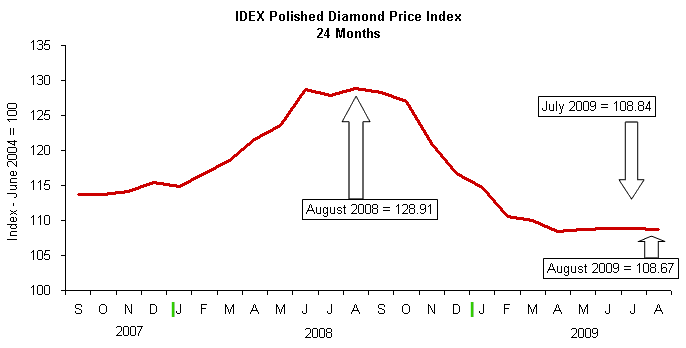
Source: IDEX Online
Month-to-Month Polished Diamond Price Trends:
August 2009 versus July 2009: (0.1%) 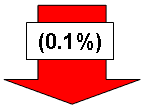
In contrast to May when larger diamond sizes showed modest price increases and June when smaller diamond prices crept up, diamond price increases – and decreases – were mixed in August. There was one notable price anomaly: the price of four-carat polished diamonds popped during the month, after losing ground over the past couple of months. In contrast, the price of five-carat diamonds dipped modestly in August.
On an annualized basis, August’s polished prices indicate no inflation – or deflation – for polished diamonds. Like the stock market, polished diamond prices could test the lows of the past couple of months, but there are indications that the economy is firming in some key global markets, so it is more likely that there is support for prices.
We believe history is a great forecaster for the future. If so, the rate of diamond price inflation would be expected rise later this year or in early 2010, especially if demand turns out to be stronger than projected. However, we continue to believe that polished diamond price inflation will return to its historic norm of about 3-4 percent annually.
On the last day of July, the IDEX Online Polished Diamond Price Index stood at 108.82, down slightly from the 108.97 level registered on the first day of the month. Unlike July, when diamond prices drove the index to just over 109.00 several times during the month, the IDEX Online Polished Price Index peaked at 109.00 early in August, and then remained in the mid-to-high 108 range for the balance of the 31-day period. The IDEX Online Polished Diamond Price Index stood at 100.00 in July 2004.
The graph below summarizes month-over-month changes in global diamond prices for the past thirteen months. Beginning in February 2008, polished diamond prices showed large gains during every month in the first half of the year. By mid-2008, price increases began moderating. In September 2008, polished diamond prices weakened, showing consistent month-to-month decreases, a trend that continued through the end of April 2009, but appears to have ended in May.
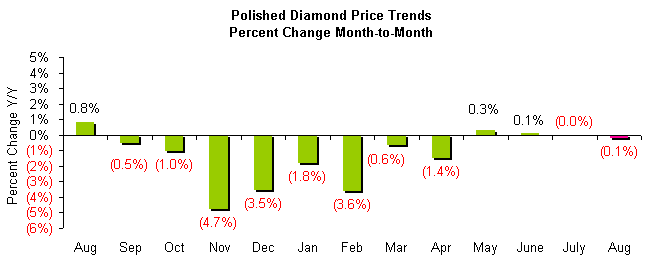
Source: IDEX Online
August 2009 versus August 2008: (15.7percent) 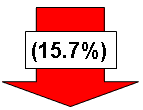
Even if diamond prices show a recovery on a month-to-month basis, the year-over-year percentage change will continue to show deflation until late in 2009, when comparisons against 2008 prices become much easier. However, longer term, we continue to predict that polished diamond prices will return to their historical trend line inflation rate of 3-4 percent annually, perhaps in 2010.
The graph below summarizes the year-over-year inflation rate by month for polished diamond prices in the global market for the past thirteen months. Comparisons are based on the daily average prices during the month versus the same month a year. The year-to-year comparison takes into account the seasonality of polished diamond demand and prices.
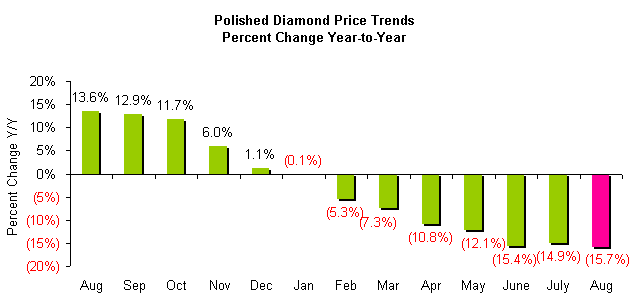
Source: IDEX Online
Day-to-Day Diamond Prices Generally Stable
Polished diamond trading patterns in August on a day-to-day basis reflected reasonable seasonal demand, with some price fluctuation as traders searched for pockets of demand.
The graph below summarizes polished diamond prices on a daily basis for the past three months. Some would call this trend stable; others would call it boring. We call it reassuring, since it appears that diamond prices have reached equilibrium. Short of some kind of a system shock, we believe that polished diamond prices bottomed in April in the current cycle.
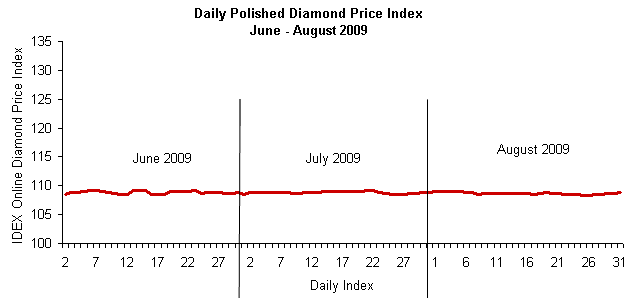
Source: IDEX Online
Polished Diamond Price by Size Are Mostly Steady
After rising rapidly in 2008, only to fall just as quickly at the end of the year, diamond prices by key sizes appear to have bottomed. Even more likely, we believe that they are poised to hold steady, and perhaps begin moving higher later this year or in early 2010.
During August, there were two interesting trends: four-carat diamond prices rose modestly, while five-carat diamond prices dipped. We cannot see any underlying fundamental demand that will sustain either of these trends.
The graph below summarizes price trends since late 2006 for the seven key sizes of diamonds; these diamonds represent just under one-third of the total value of the trading market.
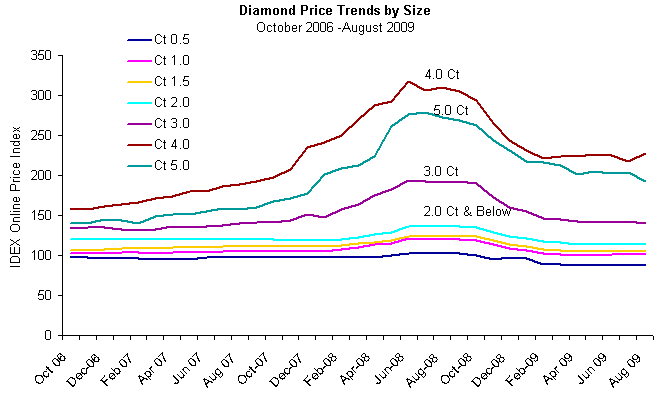
Source: IDEX Online
Month-to-Month Diamond Prices Mixed for Key Sizes
During August 2009, month-to-month – August versus July – diamond prices by size were mixed, with some sizes showing a slight price increase while other sizes decreased in price. The big surprise was the recovery in the price of four-carat polished diamonds: after dipping by 3.3percent in July, they came roaring back with a 4.5 percent gain this month.
But here’s the key piece of news: prices really didn’t vary much by size on a month-to-month basis.
The graph below summarizes the price changes for key sizes of polished diamonds on a month-over-month basis: August 2009 versus July 2009. These seven stone sizes represent about one-third of the trading market by value.
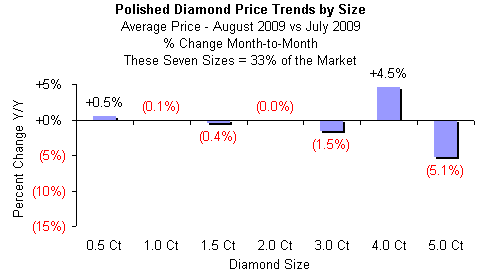
Source: IDEX Online
Year-Over-Year Diamond Prices for All Key Sizes Show Deflation
On a year-to-year comparison, polished diamond prices for the key sizes and qualities fell – some significantly – from the previous year. Virtually all sizes of diamonds showed a double-digit loss in price in August, though the overall decline diminished from earlier months. Comparisons in August were difficult, since there were a string of double-digit price gains for the larger diamond sizes in the summer of 2008.
The graph below summarizes polished diamond prices by key sizes on a year-over-year basis: August 2009 versus August 2008. These seven sizes represent about one-third of the market, by aggregate value.
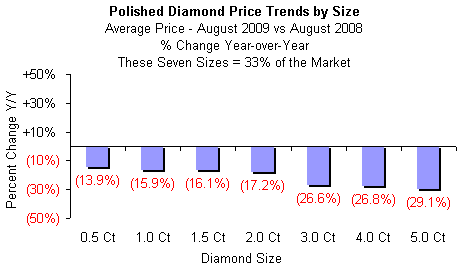
Source: IDEX Online
Forecast: Diamond Prices Have Bottomed in Current Cycle
We believe that month-to-month polished diamond prices will likely show flattish or perhaps modestly positive comparisons in subsequent months. As a result, year-over-year price comparisons will likely begin to show less disappointing comparisons by the early fall, in our opinion. At some point, probably in late 2010 or early 2011, we believe that diamond price inflation will recover to its historic trend line, reflecting annual inflation of 3-4percent.
The
The IDEX Online Diamond Price Index
The IDEX Online Diamond Price Index is a real-time index derived from actual asking prices in the global diamond industry. The IDEX Online Diamond Price Index objectively reflects price trends as they happen. The Diamond Index and Diamond Drivers were formulated following comprehensive research and analysis of the IDEX Online inventory database, aggregated since 2001. Research and development were conducted in cooperation with Dr. Avi Wohl, Senior Lecturer of Finance at the faculty of Management,
Additional information is available from IDEX Online Research. The e-mail address is diamondprices at idexonline dot com.